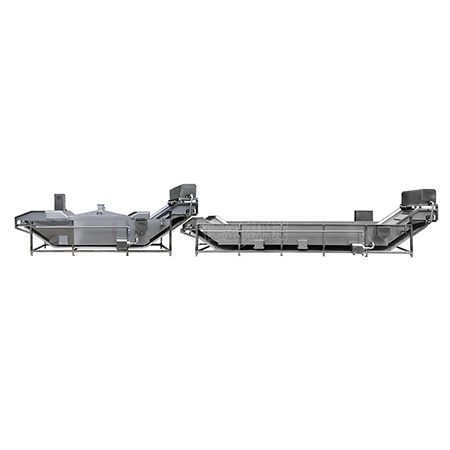
Vegetable blanching machine is a key equipment used in the field of food processing for pre-processing vegetables. By accurately controlling temperature, time, and water flow, it achieves sterilization, enzyme inactivation, color fixation, and initial softening of vegetables. Its core functions include:
Enzyme inactivation: Prolonged at high temperatures of 85-95 ℃ for 60-180 seconds, it can destroy polyphenol oxidase activity and prevent browning of vegetables such as broccoli and potatoes. Experimental data shows that the vitamin C retention rate of broccoli treated with blanching is increased to 92%, which is 37% higher than the untreated group.
Microbial control: Using a 90 ℃ hot water circulation system, the killing rate of pathogenic bacteria such as Escherichia coli and Salmonella reaches 99.99%, which meets the hygiene standards of the HACCP system for ready to eat vegetables.
Texture improvement: Through thermal penetration, the cell wall of vegetables is ruptured, softening the fiber structure. For example, carrots have a 45% decrease in hardness after blanching, making them easier to chop or juice later.
2、 Technical characteristics and professional parameters
1. Precise temperature control system
PID intelligent temperature control: using Siemens S7-1200 series PLC from Germany, combined with PT100 temperature sensor, to achieve precise temperature control of ± 0.5 ℃. For example, when processing frozen edamame, stabilize the water temperature at 92 ℃ to ensure the integrity of the bean skin and internal maturation.
Segmented heating technology: Equipped with 3 independent heating modules, it can set a three-stage temperature curve of preheating (60 ℃), blanching (90 ℃), and cooling (20 ℃) to avoid vegetable cell rupture caused by sudden temperature changes.
2. Hydrodynamics Design
Spiral propulsion system: Made of 304 stainless steel double helix blades, it drives vegetables forward at a constant speed of 15rpm, ensuring that each vegetable stays in the blanching tank with an error of ≤ 3 seconds.
Vortex jet device: Six sets of high-pressure nozzles are arranged at the bottom of the blanching tank to generate a directional water flow with a velocity of 1.2m/s, effectively flushing out impurities on the surface of vegetables. Experiments have shown that after vortex treatment, the residual sediment content of spinach is reduced to 0.02g/kg.
3. Energy saving and environmental protection architecture
Heat recovery system: using plate heat exchangers to recover waste heat from bleaching wastewater, preheating the inlet water to 50 ℃, saving 35% energy compared to traditional equipment. Taking a factory that processes 10 tons of vegetables per day as an example, it saves about 120000 yuan in steam costs annually.
Water circulation filtration: Equipped with a three-stage filtration device (50 μ m bag filter+10 μ m precision filter+UV sterilization module), the recycling rate of blanching water reaches 90%, and the water quality meets the GB 5749-2022 standard for drinking water.
Maintenance and upkeep standards
1. Daily cleaning process
After the shift ends: Rinse the inner wall of the blanching tank with a high-pressure water gun, and focus on cleaning the vegetable leaves wrapped around the propeller blades; Use food grade sodium hydroxide solution (pH=12) to cycle and clean for 30 minutes to remove protein precipitates.
Weekly deep maintenance: Disassemble 6 sets of nozzles for ultrasonic cleaning to remove scale; Check the PT100 sensor probe to ensure that there is no vegetable residue adhesion affecting the temperature measurement accuracy.
2. Maintenance of key components
Heating tube replacement: When the thermal efficiency drops to 80% of the initial value, the stainless steel electric heating tube needs to be replaced. Taking a heating tube with a power of 18kW as an example, its normal service life is 8000 hours. It is recommended to replace it preventively every 2 years.
Conveyor belt adjustment: Check the tension of the double helix conveyor belt every month, and maintain the initial tension at 220N ± 10N by adjusting the tail wheel bolt to prevent slipping or deviation.
3. Seasonal maintenance points
Summer anti-corrosion: In environments with humidity greater than 75%, dry the interior of the control cabinet with compressed air after daily shutdown to prevent electrical components from being affected by moisture and short circuiting.
Winter anti freezing cracking: When the ambient temperature is below 5 ℃, it is necessary to drain the accumulated water in the blanching tank and inject -10 ℃ antifreeze to avoid equipment freezing damage.
| Technical Parameters | |
| Overall dimensions | 11000×1200×1500mm (5 meters for blanching, 6 meters for cooling) |
| Voltage | 380V |
| Power | 6.75kW |